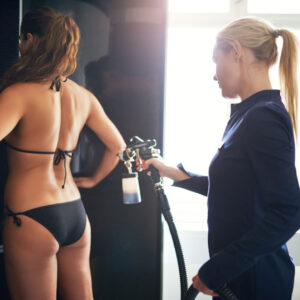
What is Ultherapy?
Ultherapy is the only non-invasive treatment cleared by the FDA to non-surgically lift and tighten skin. This ultrasound treatment counteracts the effects of gravity on your skin and reduces the natural signs of aging. Ultherapy uses the body’s regenerative response to gently and gradually lift and tighten skin on the eyebrow, under the chin, and on the neck. The treatment can also smooth lines and wrinkles on the décolletage (chest area).
Ultherapy Uses Ultrasound Energy
Ultherapy is an ultrasound-based cosmetic treatment that works below the skin’s surface to lift, tone, and tighten loose skin. Its goal is to counteract time’s and gravity’s effects. However, this treatment may do more than visibly tighten and lift your skin. It may also help stimulate new collagen in the skin, resulting in a more youthful appearance. Ultherapy directs sound waves underneath the skin to reach the collagen-producing area. The tissue is then gently heated. This is designed to help your skin’s collagen contract and firm up.
Ultherapy treatment is increasingly popular for several reasons. It is non-invasive, meaning no incisions in the skin are necessary. And, it is the only FDA-approved cosmetic procedure that uses cutting-edge ultrasound imaging to improve drooping skin and fine lines. Your Ultherapy practitioner can see the best location for treatment through Ultherapy’s ultrasound imaging. This helps to target the area(s) that will benefit you most.
Ultherapy and the Natural Aging Process
As you age, after the age of 20 you lose 1-2% of collagen per year. This causes your skin to hang loosely and become slack. Your skin may also become dry and rough. Ultherapy treatment involves using ultrasound technology to tighten, lift, and smooth your skin’s texture. The areas around the eyes and the mouth may especially benefit from this type of treatment.
Can Ultherapy replace a face lift?
Ultherapy treats the deep foundational layer addressed in cosmetic surgery, but won’t duplicate the results of a facelift. Ultherapy is a great alternative, however, especially for those not ready for surgery or for patients looking to extend the effects of cosmetic surgery.
Tightening and Wrinkle Reduction
Following Ultherapy, your results progress cumulatively over a 3-6 month period with full results achieved at six months. You might notice improvement and tightening in your lower and upper eyelid areas. Your eyes might even appear larger. You may notice fewer wrinkles and lines around your eye area. This procedure pairs well with other types of cosmetic treatments including facial fillers or toxins, such as Botox. If you decide to pair Ultherapy with toxins or fillers, they should be administered after Ultherapy.
Good Ultherapy Candidates
Good Ultherapy candidates notice moderate or mild skin droopiness and are concerned about moderate or mild signs of aging. Virtually any healthy adult may be a good candidate for Ultherapy. In addition to being in great health, you should have some decent skin elasticity as determined by your cosmetic provider. During your initial Ultherapy consultation, your cosmetic provider will perform a skin evaluation. They will also go over your concerns with you and discuss your goals.
Poor Ultherapy Candidates
Patients with bleeding disorders may not be good candidates for Ultherapy. This is also true for people with active bacterial or viral infections. Ultherapy also isn’t recommended for patients with autoimmune diseases, which affect nearly 24 million people in the US. People with connective tissue disorders might want to avoid Ultherapy as well. Areas of your body containing implants should not be treated. You should also delay Ultherapy if you currently have cystic acne or an open wound in the area needing treatment.
Of course, the best way to find out if you’re an Ultherapy candidate is to consult with one of our practitioners.
Best Treatment Zones for Ultherapy
Ultherapy usually targets the following parts of the body:
- Chest and bust area
- Beneath the chin
- Jowls
- Neck
- Face
It can also target the areas around your mouth and eyes, as well as your eyebrows.
How does Ultherapy differ from laser treatments?
Ultherapy uses sound energy or ultrasound which has unique properties that allow it to bypass the surface of the skin to treat depths not matched by any other non-invasive cosmetic device. Ultherapy ultrasound stimulates collagen production in the skin’s foundation, resulting in a clinically significant lift of tissue over 2-3 months. Lasers rely on light energy, which cannot reach deeper skin layers at an optimal temperature, so laser treatments typically only treat superficial skin and are not FDA-cleared to lift skin. Since the two technologies often treat different types of skin issues, they’re actually very compatible.
How does Ultherapy stimulate the creation of collagen?
Ultherapy deposits focused ultrasound energy deep beneath the skin at the optimal temperature for collagen regeneration. The treatment jumpstarts a natural process, known as neocollagenesis, to produce fresh, new collagen. Ultherapy doesn’t involve any creams, fillers or toxins; it just relies on your body’s own collagen-building process for natural, noticeable results.
How long does an Ultherapy® treatment take?
The length of the treatment depends on the area treated and your individual treatment plan. A face and neck procedure typically takes 60-90 minutes, while a chest treatment takes approximately 30 minutes.
Will I need to take time off?
With Ultherapy, there is no downtime. After your procedure, you can resume your normal activities immediately, without having to follow any special post-treatment measures.
Does Ultherapy Hurt?
You might experience some discomfort with Ultherapy depending on the area being treated. Some treatment areas aren’t as comfortable as others. For example, the skin above your eyebrow is usually less comfortable than your neck area. Everyone experiences Ultherapy sensations differently, so what another patient may describe as uncomfortable might feel okay to you. To manage discomfort, you can use topical anesthetics or oral medications. Other possible solutions include numbing cream, breathing techniques, and music. Your cosmetic specialist will tailor pain management specifically for you to keep you as comfortable as possible.
When Will I See Results?
Ultherapy results progress cumulatively over a 3-6 month period as the collagen production ramps up. Full results are usually achieved at six months post-treatment. Results usually last up to two years. How long your Ultherapy results last may depend on multiple factors including:
- Your age at the time of treatment
- How well you take care of your skin after treatment.
- Your lifestyle habits. Unhealthy lifestyle habits may lead to subpar results.
How to Extend the Longevity of Your Results
You can extend your Ultherapy results’ longevity by prioritizing good skin care. Let’s go over several things that may affect your skin’s health and how controlling them may keep your skin’s collagen strong and healthy.
Ultraviolet Ray Damage

Skin aging is inevitable. However, you can reduce your chances of experiencing premature aging by wearing ample sunscreen and not using tanning beds. Rather than using a tanning bed, consider a spray tan instead. If you plan to be out in the sun for an extended period, use sunscreen with a sun protection factor, or SPF, rating of 30+, protective clothing, and a hat, and seek shade if possible. Check the expiration date on your sunscreen. Store your sunscreen in a dry, dark, and cool place so that it maintains its potency. Use a broad-spectrum sunscreen that helps protect your skin from both UVA and UVB rays. UVB rays also cause sunburns, while UVA rays may cause premature aging.
Smoking
Avoiding nicotine consumption helps to keep your skin’s collagen healthy following Ultherapy. Steering clear of secondhand smoke might not be possible if somebody in your home smokes. However, you shouldn’t consume nicotine directly. If you currently smoke, consider quitting. Avoid using smoking cessation tools containing nicotine. Avoiding nicotine is important following Ultherapy because collagen comprises most of your skin’s supporting structure. If you view collagen through a microscope, the collagen looks similar to mesh. Because nicotine has a sticky quality, it can become caught in your collagen mesh, making it sag. Deep wrinkles may form due to the skin’s sagging support structure.
Eating Vegetables and Fruits
Eating plenty of vegetables and fruits can help your skin look younger. A citrus fruit, like an orange, contains high vitamin C levels. This essential micronutrient helps your body generate collagen. Your body produces collagen when you consume collagen-containing protein sources, like lean fish, egg whites, and chicken. What if you aren’t consuming enough of this nutrient? You don’t have to take a dietary supplement. Instead, simply add citrus fruits to your diet. In addition to eating fruits like clementines, you could easily add a lime or lemon wedge to your morning tea. Grapefruit juice can also be added to the tea. Swiss chard, spinach, and kale are also filled with micronutrients that can help your skin produce collagen.
How many Ultherapy® treatments will I need?
Most patients only need one treatment. However, based on the degree of skin laxity, the biological response to ultrasound energy and the individual’s collagen-building process, some patients benefit from additional treatments. Because skin continues to age, future touch-up treatments can help patients keep pace with the body’s natural aging process.
What to Expect During Ultherapy
Ultherapy can help your skin produce collagen using heat from light or sound waves, respectively. Ultherapy has a few advantages compared with laser-based treatments. For starters, lasers may impact your skin’s surface. However, the sound waves used in Ultherapy are designed to pass through your upper skin layers and impact your deepest layers. This makes it more effective and less invasive.
Preparing for Treatment
Because Ultherapy is non-invasive, a lot of preparation is not required. General anesthesia is not needed so fasting 12 hours prior is not necessary. You are free to exercise, drink, and eat before your treatment. An important part of preparing for treatment, though, is to take off any cosmetics you’ve applied to your treatment area.
During Treatment
A traditional facelift may take several hours. However, an Ultherapy session generally lasts for 60-90 minutes if you are targeting the neck or face. Meanwhile, it may take only 30 minutes if you are undergoing a chest treatment. This means you can go in for Ultherapy and resume your normal activities right after your treatment. There is no downtime.
After the Procedure
Some temporary redness is common after Ultherapy is performed. Some patients may also experience mild swelling. These effects typically resolve themselves within 24 hours
Are there any side effects?
The skin might appear flushed at first, but the redness should disappear within a few hours. Some patients experience slight swelling, tingling or tenderness to the touch, but these are temporary in nature. Other, less common post-procedural effects may include temporary bruising or numbness on small areas of skin. As with any medical procedure, there is the possibility for other rare effects, which your practitioner will review with you.
For full product and safety information visit ultherapy.com/IFU
How much does an Ultherapy® procedure cost?
The cost of an Ultherapy® treatment ranges depending upon the area treated and factors such as geographic location and individual physician practices. Since the treatment is so personalized, to get the most accurate price quote, it is best to speak with one of our providers.
Book Your Consultation
Ultherapy works by using ultrasound energy to stimulate collagen production and help reduce skin laxity or looseness. The result of Ultherapy treatment varies from patient to patient. However, it may help reverse the effects of the natural aging process by lifting and tightening the skin.
Schedule a one-on-one consultation with our Ultherapy specialist so they can assess your skin, address your concerns, and determine if Ultherapy is right for you. Call us at 757-313-5813 or book your appointment or click here to request an appointment.
Interested in Ultherapy?



